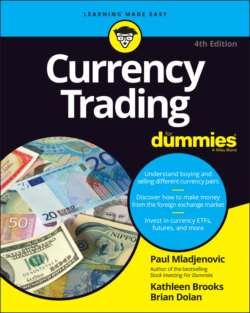Читать книгу Currency Trading For Dummies - Kathleen Brooks - Страница 14
Currencies as the trading vehicle
ОглавлениеIf you’ve heard anything at all about the forex market, it’s probably that it’s the largest financial market in the world, at least in terms of daily trading volumes. To be sure, the forex market is unique in many respects. The volumes are, indeed, huge, which means that liquidity is ever present. It also operates around the clock six days a week, giving traders access to the market almost any time they need it. (In Chapter 2, we give you a sense of the scale of the forex market and how it operates on a daily basis. In Chapter 3, we look at who the major forex players are.)
Few trading restrictions exist — no daily trading limits up or down, no restrictions on position sizes, and no requirements on selling a currency pair short. (We cover all the mechanics and conventions of currency trading in Chapter 4.)
Selling a currency pair short means you’re expecting the price to decline. Because of the way currencies are quoted and because currency rates move up and down all the time, going short is as common as going long.
Most of the action takes place in the major currency pairs, which pit the U.S. dollar (USD) against the currencies of the Eurozone (the European countries that have adopted the euro as their currency), Japan, Great Britain, and Switzerland. There are also plenty of trading opportunities in the minor pairs, which see the U.S. dollar traded against the Canadian, Australian, and New Zealand dollars. On top of that, there’s cross-currency trading, which directly pits two non-USD currencies against each other, such as the Swiss franc against the Japanese yen. Altogether, there are anywhere from 15 to 20 different major currency pairs, depending on which forex brokerage you deal with. (See Chapters 5 and 7 for a look at the fundamental and market factors that affect the most widely traded currency pairs.)
Most individual traders trade currencies via the internet — on a desktop, tablet, or even smartphone — through a brokerage firm. Online currency trading is typically done on a margin basis, which allows individual traders to trade in larger amounts by leveraging the amount of margin on deposit.
One of the key features of the forex market is trading with leverage. The leverage, or margin trading ratios, can be very high, sometimes as much as 200:1 or greater, meaning a margin deposit of $1,000 could control a position size of $200,000. (Note: Margin rules can vary by country.) Trading on margin is the backdrop against which all your trading will take place. It has benefits, but it carries its own rules and requirements as well. Leverage is a two-edged sword, amplifying gains and losses equally, which makes risk management the key to any successful trading strategy.
Before you ever start trading in any market, make sure you’re only risking money that you can afford to lose, what’s commonly called risk capital. Risk management is the key to any successful trading plan. Without a risk-aware strategy, margin trading can be an extremely short-lived endeavor. With a proper risk plan in place, you stand a much better chance of surviving losing trades and making winning ones. (We incorporate risk management throughout this book, but especially in Chapters 11 and 18.)
Downturns don’t affect the forex market as they do other financial markets. Selling a currency pair is normal in the forex market. This is different from other markets — for example, stock markets, where retail investors rarely sell physical stocks due to the financial risks involved. Because selling is so common in the forex market, the forex market is fairly immune to downturns. You trade one currency against another, so something is always going up, even in times of financial crisis. (We talk more about risk on and risk off and what this means for currencies in Chapter 2.)
